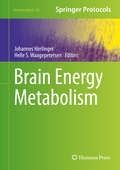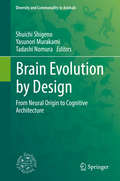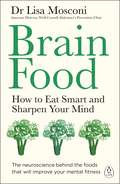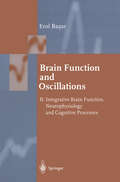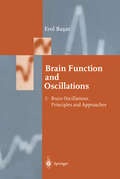- Table View
- List View
Brain Edema: Proceedings of the Sixth International Symposium, November 7–10, 1984 in Tokyo
by MariaSpatz IgorKlatzo YutakaInabaBrain Edema / Cerebello Pontine Angle Tumors: Pathophysiology and Therapy / Diagnosis and Surgery (Advances in Neurosurgery #1)
by K. Schürmann, M. Brock, H.-J. Reulen and D. VothThis volume contains the papers presented at the 24th Annual Meeting of the Deutsche Gesellschaft fur Neurochirurgie, held in Mainz, Western Germany, on April 30 - May 3, 1973. Deliberate choice was made of two crucial still hotly debated subjects which, for ages, have meant a source of constant worry, and nights without sleep to every neurosurgeon. Just as long as our special field exists, there have been the problems of how to control brain edema and ·of how to reduce lethality and the secondary lesions in surgery of cerebello-pontine angle tumors. Concerning the first subject, new pathological, pathophysiological and chemical aspects, the mechanisms of brain edema formation and resolution are presented in the hope for better understanding. Furthermore, the relationship between brain edema, intracranial pressure, cerebral blood flow and metabolism are discussed. Finally, the therapeutical consequences as well as the results of experimental and clinical work are presented, and a comparison of effects between different methods (hypertonic solutions, diuretics, steroids, controlled hyperventilation, hyperbaric oxygen) is given. Concerning the second main subject, any important contributions to the early diagnosis of cerebello-pontine angle tumors have been included. Nevertheless, it is of utmost interest for the neurosurgeon to know which approach he is to prefer for the different stages of tumor size and to be familiar with the trans labyrinthine approach or the posterior craniotomy, as well as with the importance of the use of the microscope in neurosurgery, the preservation of the facial nerve and, in certain cases, its repair.
Brain Edema IX: Proceedings of the Ninth International Symposium Tokyo, May 16–19, 1993 (Acta Neurochirurgica Supplement #60)
by KintomoTakakura Hans-J. Reulen AnthonyMarmarou ToshihikoKuroiwa Konstantin-A. Hossmann AlexanderBaethmann UmeoItoThe first international symposium on brain edema was held in Vienna/ Austria in 1965 followed by altogether eight meetings since. The most recent was organized in Y okohama by the Department of Neurosurgery of the Musashino Red Cross Hospital, Tokyo. The continuing interest of both, clinicians and experimental scientists alike may be attributable to the fact that brain edema is a common denominator of many cerebral disorders, which under acute conditions threatens life and weIl-being of afflicted patients. Although progress in understanding as weIl as treatment can be recognized since 1965 many problems remain, particularly concerning the control of brain edema under acute conditions, as in trauma or ischemia. A quantum leap was the distinction of the cytotoxic and vasogenic brain edema prototypes as advanced by Igor Klatzo, providing for transition from a morphological to functional understanding now. The recent brain edema meetings were certainly benefiting from developments of both, molecular neurobiology on the one hand side and functional brain imaging at an ever-increasing resolution on the other, such as magnetic resonance imaging orpositron emission tomography. The international symposium in San Diego 1996 may witness further breakthroughs, hopefully also of effective treatment modalities. The symposium in Y okohama was dedicated to the "Legacy of 28 Years of Brain Edema Research" as a reminder of accomplishments as weIl as remaining challenges.
Brain Edema VIII: Proceedings of the Eighth International Symposium, Bern, June 17–20, 1990 (Acta Neurochirurgica Supplement #51)
by Hans. J. Reulen Alexander Baethmann Joseph Fenstermacher Anthony Marmarou Maria Spatz25 years have passed since a small group met for the First International Symposia on Brain Edema in Vienna. Subsequent Symposia were held in Mainz, Montreal, Berlin, Groningen, Tokyo and Baltimore. During this time we have witnessed a virtual explosion of the number of publications in this field and our basic and clinical understanding of this disease process has increased tremendously. Our meetings have always been a landmark to take stock of our experience so far and to provide perspectives toward future developments. In addition, it always was a good opportunity to renew old friendship and to make new friends. This volume is a compilation of papers presented at the Eighth International Symposium on Brain Edema held on June 17-20, 1990 in Bern, Switzerland. During this Symposium 158 papers were presented as oral or poster presentations. This considerable number of papers was chosen from more than 230 abstracts that were received. The organizers wish to thank the Advisory Committee for the work done in paper selection and focus on the Symposium. Appreciation is also given to all persons, who have contributed to the success of this meeting, the Chairmen, the participants and last but not least all the staff who worked behind the scene.
Brain Edema X: Proceedings of the Tenth International Symposium San Diego, California, October 20–23, 1996 (Acta Neurochirurgica Supplement #70)
by ZbigniewCzernicki ToshihikoKuroiwa Julian T. Hoff UmeoIto AnthonyMarmarou AlexanderBaethmann Hans J. Raulen Lawrence F. Marshall Hector E. JamesThis volume is a compilation of papers presented at the Tenth International Symposium on Brain Edema held on October 20-23, 1996, in San Diego, California. This follows the sequence of meetings that was initiated 31 years ago in the First International Symposium held in Vienna. Subsequent symposiums were held in Mainz, Montreal, Berlin, Groningen, Tokyo, Baltimore, Bern, and Tokyo CY okohama). A considerable number of papers was chosen from over 100 papers that were received. The organizers wish to thank the Advisory Committee for the excellent work done in selection of the papers. We also wish to thank all the persons who contributed to the success of the Tenth International Symposium, especially the staff who worked behind the scenes. These papers were reviewed, edited, approved or disapproved by the Editorial Board. Those manuscripts that were felt not pertinent to this publication were not accepted by the Editorial Board. Therefore, the excellent quality of those that are in the book are a reflection of the authors' dedication and work and that of those of the Editorial Board in their review process. For the reader's convenience, the papers are structured according to the various disease processes which are associated with the primary topic: hypertension, hydrocephalus, infection, ischemia, tumor, etc. We do hope that the reader will enjoy the articles and that they will provide an impetus and insight for future work.
Brain Edema XI: Proceedings of the 11th International Symposium, Newcastle-upon-Tyne, United Kingdom, June 6–10, 1999 (Acta Neurochirurgica Supplement #76)
by A. David MendelowBrain edema is found in a wide variety of clinical disorders including stroke, intracerebral haemorrhage, subarachnoid haemorrhage, head injury, brain tumors and hydrocephalus. This volume brings together clinical and basic scientists from all over the world. Their expertise in the understanding of brain edema and shifts in brain water compartments has led to a further significant step in our understanding of those diseases characterized by brain edema. This book has also drawn on the expertise of the International Advisory Board of the Brain Edema Society, who have carefully summarized each section, thus providing an easy-to-read summary of the latest advances in each subject. The book is therefore much more than a collection of papers: it represents a critical appraisal and puts each paper into modern scientific context. The greatest advances have come from the rapid development of modern imaging techniques, especially with magnetic resonance imaging (MRI). Imaging can now produce "water maps” and "metabolic profiles” that bring brain metabolism and water content right into every clinic with access to MRI. This book provides the background knowledge to understand these pathophysiological changes.
Brain Edema XII: Proceedings of the 12th International Symposium, Hakone, Japan, November 10–13, 2002 (Acta Neurochirurgica Supplement #86)
by T. KuroiwaBrain edema is a simple phenomenon – an abnormal increase of brain tissue volume by the increase of brain tissue water content. However the etiology is not simple and relating to a wide variety of neurological disorders including ischemia, trauma, tumor, hemorrhage and hydrocephalus. It is still a major cause of death in the neurological/neurosurgical ward. This volume is an up-to-date report on progress in brain edema research, diagnosis and treatment, including papers presented at the 12th International Symposium on Brain Edema and Brain Tissue Injury in 2002. Major topics include molecular biology and blood-brain barrier disorders, ischemic and traumatic brain edema, imaging and diagnosis of brain edema, treatment and radiation effect. Various papers in the rapidly growing fields of neuroimaging and molecular medicine are also included.
Brain Edema XIII (Acta Neurochirurgica Supplement #96)
by Julian T. Hoff Richard F. Keep Guohua Xi Ya HuaThis volume contains 93 papers from internationally recognized experts in the field of brain edema and brain injury. The papers include human and animal studies on edema following stroke, cerebral hemorrhage, traumatic brain injury, spinal cord injury and hydrocephalus. Papers also address fluid dynamics in the brain (including the role of aquaporins).
Brain Edema XIV (Acta Neurochirurgica Supplement #106)
by Zbigniew Czernicki Alexander Baethmann Umeo Ito Yoichi Katayama Toshihiko Kuroiwa David MendelowThe XIV International Symposium on Brain Edema and Brain Tissue Injury took place in Warsaw, Poland, on 11–14 June 2008. Two prominent members of the International Society for Brain Edema: Dr. Igor Klatzo and Dr. Julien Hoff have passed away after the last 2005 Symposium in Ann Arbor, USA. Dr. Igor Klatzo was actually the founder of the Society, and the Advisory Board decided to commemorate Dr. Igor Klatzo by introducing a lecture named after him to be given at the Symposium. Prof. Dr. Hans-Jürgen Reulen has been honored to give the frst Igor Klatzo lecture entitled “Bulk Flow and Diffusion revisited, and Clinical Applications”. This volume contains 65 out of the 104 papers presented at the Symposium as lectures or posters. The topics of the Symposium were similar to those discussed at the previous ones. Many discussions focused on clinical work especially diagnosis, subarachnoid hemorrhage, hydrocephalus, and traumatic brain injury. Diagnosis and therapy, including surgical methods, have also been verifed. Much attention was drawn to the application of decompressive craniectomy in the treatment of posttr- matic intracranial hypertension. The pathomechanisms of brain edema and tissue injury studied in experimental models have been also presented.
Brain Edema XV (Acta Neurochirurgica Supplement)
by Yoichi Katayama, Takeshi Maeda and Toshihiko KuroiwaMore than 60 papers written by internationally recognized experts cover the broad spectrum of brain edema. The main topics treated are: ischemia & hemorrhage, trauma (experimental and clinical), cerebral hemorrhage, tumor, hydrocephlaus & intracranial pressure (ICP), neuromonitoring & neuroimaging, treatments, blood brain barrier, and miscellaneous.
Brain Edema XVI: Translate Basic Science into Clinical Practice (Acta Neurochirurgica Supplement #121)
by Richard L. Applegate Gang Chen Hua Feng John H. ZhangIn this book, leading world authorities on brain edema and neurological disorders/injuries and experts in preconditioning join forces to discuss the latest progress in basic sciences, translational research, and clinical management strategies relating to these conditions. The range of topics covered is wide, including microglia, energy metabolism, trace metals and ion channels, vascular biology, cellular treatment, hemorrhagic stroke, novel technological advances, anesthesia and medical gases, pediatric brain edema, neuroimaging, behavioral assessment, clinical trials, peripheral to central signaling pathways, preconditioning translation, and animal models for preconditioning and brain edema research. The book comprises presentations from Brain Edema 2014, the joint meeting of the 16th International Conference on Brain Edema and Cellular Injury and the 3rd Symposium on Preconditioning for Neurological Disorders, held in Los Angeles on September 27–30, 2014.
Brain Embolism
by Louis R. Caplan Warren J. ManningThe only source to fully cover every aspect of brain embolism, this guide analyzes the causes, symptoms, diagnosis, and management of this disorder-providing a detailed overview of major topics pertinent to embolism including donor sources, recipient sites, embolic material, recipient brain supply arteries, vascular and brain pathology, and the tre
The Brain, Emotion, and Depression
by Edmund T. RollsThere are myriad questions that emerge when one considers emotions and decision-making: What produces emotions? Why do we have emotions? How do we have emotions? Why do emotional states feel like something? What is the relationship between emotion, reward value, and subjective feelings of pleasure? How is the value of 'good' represented in the brain? Will neuroeconomics replace classical microeconomics? How does the brain implement decision-making? Are gene-defined rewards and emotions in the interests of the genes? Does rational multistep planning enable us to go beyond selfish genes to plans in the interests of the individual? The Brain, Emotion, and Depression addresses these issues, providing a unified approach to emotion, reward value, economic value, decision-making, and their brain mechanisms. The evolutionary, adaptive value of the processes involved in emotion, the neural networks involved in emotion and decision making, and the issue of conscious emotional feelings are all considered. The book will be valuable for those in the fields of neuroscience, neurology, psychology, psychiatry, biology, animal behaviour, economics, and philosophy from the advanced undergraduate level upwards, and for all interested in emotion and decision-making.
The Brain, Emotion, and Depression
by Edmund T. RollsThere are myriad questions that emerge when one considers emotions and decision-making: What produces emotions? Why do we have emotions? How do we have emotions? Why do emotional states feel like something? What is the relationship between emotion, reward value, and subjective feelings of pleasure? How is the value of 'good' represented in the brain? Will neuroeconomics replace classical microeconomics? How does the brain implement decision-making? Are gene-defined rewards and emotions in the interests of the genes? Does rational multistep planning enable us to go beyond selfish genes to plans in the interests of the individual? The Brain, Emotion, and Depression addresses these issues, providing a unified approach to emotion, reward value, economic value, decision-making, and their brain mechanisms. The evolutionary, adaptive value of the processes involved in emotion, the neural networks involved in emotion and decision making, and the issue of conscious emotional feelings are all considered. The book will be valuable for those in the fields of neuroscience, neurology, psychology, psychiatry, biology, animal behaviour, economics, and philosophy from the advanced undergraduate level upwards, and for all interested in emotion and decision-making.
Brain Energetics and Neuronal Activity: Applications to fMRI and Medicine
by Robert G. Shulman Douglas L. RothmanThis book is unique in linking in vivo 13C NMR measurements of neuronal activity and energetics with applications to functional imaging and certain disease states It provides a fundamental neurochemical explanation of brain activity applicable to functional imaging, theories of neuronal activity and disease states, e.g. epilepsy, psychiatric diseases and developmental disorders. Novel and potentially controversial Will inspire future research directions
Brain Energy Metabolism (Neuromethods #90)
by Johannes Hirrlinger and Helle S. WaagepetersenBrain Energy Metabolism addresses its challenging subject by presenting diverse technologies allowing for the investigation of brain energy metabolism on different levels of complexity. Model systems are discussed, starting from the reductionist approach like primary cell cultures which allow assessing of the properties and functions of a single brain cell type with many different types of analysis, however, at the expense of neglecting the interaction between cell types in the brain. On the other end, analysis in animals and humans in vivo is discussed, maintaining the full complexity of the tissue and the organism but making high demands on the methods of analysis. Written for the popular Neuromethods series, chapters include the kind of detailed description and key implementation advice that aims to support reproducible results in the lab.Meticulous and authoritative, Brain Energy Metabolism provides an ideal guide for researchers interested in brain energy metabolism with the hope of stimulating more research in this exciting and very important field.
Brain Evolution by Design: From Neural Origin to Cognitive Architecture (Diversity and Commonality in Animals)
by Shuichi Shigeno Yasunori Murakami Tadashi NomuraThis book presents a new, detailed examination that explains how elegant brains have been shaped in evolution. It consists of 19 chapters written by academic professionals in neuroscience, opening with the origin of single-celled creatures and then introducing primordial types in invertebrates with the great abundance of the brains of vertebrates. Important topics are provided in a timely manner, because novel techniques emerged rapidly—as seen, for examples, in the next-generation sequencers and omics approaches. With the explosion of big data, neural-related genes and molecules is now on the radar. In fact, Europe’s big science and technology projects, a €1 billion plan called the Human Brain Project and the Blue Brain Project to understand mammalian brain networks, have been launched in recent years. Furthermore, with the rise of recently advanced artificial intelligence, there is great enthusiasm for understanding the evolution of neural networks. The views from brain evolution in nature provide an essential opportunity to generate ideas for novel neuron- and brain-inspired computation. The ambition behind this book is that it will stimulate young scientists who seek a deeper understanding in order to find the basic principles shaping brains that provided higher cognitive functions in the course of evolution.
Brain Failure (Update in Intensive Care and Emergency Medicine #9)
by John W. Holaday DavidBihariThis book proves essential to understanding the problem of brain failure by emphasizing the various therapeutic approaches which have previously been somewhat neglected. The book summarizes the mechanisms involved in the pathogenesis of the various forms of brain failure, examining in detail structural and examining metabolic causes. Special consideration has been given to patients with severe head trauma, stroke, subarachnoid haemorrhage and to a variety of metabolic causes of coma. The relationship between cerebral blood flow and cerebral metabolic rate is explored, providing important conclusions with regard to therapy. New techniques of monitoring brain failure are described and their clinical usefulness defined, providing intensive care physicians, anaesthesiologists and neurologists a solid basis on which to build their knowledge of the brain-failure patient.
Brain Food: How to Eat Smart and Sharpen Your Mind
by Dr Lisa MosconiA call to action to prevent a brain health crisis - does for diet what Why We Sleep does for sleep 'One of the most exciting reads on brain health that I have ever come across ... I cannot recommend this book enough' - Dr Rupy Aujla, author of The Doctor's KitchenWe often talk about how our diets affect our fitness - but we don't discuss how they affect the hungriest organ in the body, the brain. And it has surprising dietary needs that differ from the rest of our body. Brain Food uses cutting-edge research to highlight the connection between nutrition and our brain's health, busting through pseudoscience and demonstrating how we can all change our diet most effectively. Based partly on her own discoveries, and using emerging science, for example on the connection between the brain and the gut, Dr Lisa Mosconi, an expert in both neuroscience and nutrition, reveals the foods and drinks that can prevent dementia, stress, cognitive decline and memory loss - no matter how old we are. Innovative and timely, and with accompanying brain-boosting recipes and lists of what to eat and what to avoid, Brain Food provides the ultimate plan for maximising our brain power. 'A critically important book. If you want to keep and save your brain you have to get your food right. Brain Food will help you do just that in a delicious, easy way' - Daniel G. Amen, author of Memory Rescue
A Brain-Friendly Life: How to Manage Cognitive Overload and Reduce Glitching
by Marisa MencholaModern life is brain-unfriendly: We are flooded with information and excessive cognitive demands, when we are often already depleted from chronic stress, sleep deprivation, and health issues. Many of us experience frequent 'glitches' or memory lapses, despite tests showing there is nothing wrong with our brains. This book provides concrete strategies, derived from neuropsychological science and clinical practice, to help people improve how they function in daily life.Menchola draws on her experience as a clinical neuropsychologist who has worked with a widely diverse group of patients, to translate the findings from highly controlled research into concrete strategies that people can implement in their messy worlds to make their days more brain-friendly. The book also provides advice on how to address those factors that drain our brain resources, and gives guidance on when and how to seek a neuropsychological evaluation.It is valuable reading for anyone experiencing frustrating cognitive problems that are not due to brain disease. It is also essential for neuropsychologists, psychologists and physicians in primary care, psychiatry, and neurology, who need a resource to offer to patients to help their healthy brains function better.
A Brain-Friendly Life: How to Manage Cognitive Overload and Reduce Glitching
by Marisa MencholaModern life is brain-unfriendly: We are flooded with information and excessive cognitive demands, when we are often already depleted from chronic stress, sleep deprivation, and health issues. Many of us experience frequent 'glitches' or memory lapses, despite tests showing there is nothing wrong with our brains. This book provides concrete strategies, derived from neuropsychological science and clinical practice, to help people improve how they function in daily life.Menchola draws on her experience as a clinical neuropsychologist who has worked with a widely diverse group of patients, to translate the findings from highly controlled research into concrete strategies that people can implement in their messy worlds to make their days more brain-friendly. The book also provides advice on how to address those factors that drain our brain resources, and gives guidance on when and how to seek a neuropsychological evaluation.It is valuable reading for anyone experiencing frustrating cognitive problems that are not due to brain disease. It is also essential for neuropsychologists, psychologists and physicians in primary care, psychiatry, and neurology, who need a resource to offer to patients to help their healthy brains function better.
The Brain from 25,000 Feet: High Level Explorations of Brain Complexity, Perception, Induction and Vagueness (Synthese Library #317)
by Mark A. ChangiziIn The Brain from 25,000 Feet, Mark A. Changizi defends a non-reductionist philosophy and applies it to a variety of problems in the brain sciences. Some of the key questions answered are as follows. Why do we see visual illusions, and why are illusions inevitable for any finite-speed vision machine? Why aren't brains universal learning machines, and what does the riddle of induction and its solution have to do with human learning and innateness? The author tackles such questions as why the brain is folded, and why animals have as many limbs as they do, explaining how these relate to principles of network optimality. He describes how most natural language words are vague and then goes on to explain the connection to the ultimate computational limits on machines. There is also a fascinating discussion of how animals accommodate greater behavioral complexity. This book is a must-read for researchers interested in taking a high-level, non-mechanistic approach to answering age-old fundamental questions in the brain sciences.
Brain Function and Oscillations: Volume II: Integrative Brain Function. Neurophysiology and Cognitive Processes (Springer Series in Synergetics)
by Erol BaşarNeuroscience is ripe for a paradigm change as Freeman and Mountcastle describe. Brain Oscillations provide an important key to this change. In this book the functional importance of the brain's multiple oscillations is treated with an integrative scope. According to the author, neurophysiology and cognition demand integrative approaches similar to those of Galilei and Newton in physics and of Darwin in biology. Not only the human brain but also lower brains and ganglia of invertebrates are treated with electrophysical methods. Experiments on sensory registration, perception, movement, and cognitive processes related to attention, learning, and memory are described. A synopsis on brain functions leads to a new neuron assemblies doctrine, extending the concept of Sherrington, and new trends in this field. The book will appeal to scientists and graduate students.
Brain Function and Oscillations: Volume I: Brain Oscillations. Principles and Approaches (Springer Series in Synergetics)
by Erol Başarby W. J. Freeman These two volumes on "Brain Oscillations" appear at a most opportune time. As the "Decade of the Brain" draws to its close, brain science is coming to terms with its ultimate problem: understanding the mechanisms by which the immense number of neurons in the human brain interact to produce the higher cognitive functions. The ideas, concepts, methods, interpretations and examples, which are presented here in voluminous detail by a world-class authority in electrophysiology, summarize the intellectual equipment that will be required to construct satisfactory solutions to the problem. Neuroscience is ripe for change. The last revolution of ideas took place in the middle of the century now ending, when the field took a sharp turn into a novel direction. During the preceding five decades the prevailing view, carried forward from the 19th century, was that neurons are the carriers of nerve energy, either in chemical or electrical forms (Freeman, 1995). That point of view was enormously productive in terms of coming to understand the chemical basis for synaptic transmission, the electrochemistry of the ac tion potential, the ionic mechanisms of membrane currents and gates, the functional neuroanatomy that underlies the hierarchy of reflexes, and the neural fields and'their resonances that support Gestalt phenomena. No bet ter testimony can be given of the power of the applications of this approach than to point out that it provides the scientific basis for contemporary neu rology, neuropsychiatry, and brain imaging.
Brain Function and Responsiveness in Disorders of Consciousness
by Martin M. Monti Walter G. SannitaThis book provides up-to-date information on all aspects of brain function and responsiveness in patients with severe disorders of consciousness. Topics considered include the mechanisms and measures of consciousness; perfusional, metabolic, and fMRI markers of responsiveness; responsiveness to pain; the role of brain–computer interface techniques; electrophysiology; cortical excitability; autonomic responsiveness; the natural history of vegetative and minimally conscious states; and prediction of outcome. Brain neuroimaging has documented residual responsiveness in the vegetative state. The scientific impact of this seminal evidence has generated a schism between neuroscience and the clinical criteria defining consciousness and responsiveness. Our current understanding of human consciousness must be reconsidered also in view of the emotional impact on the public and the far-reaching implications for diagnosis, prognosis, medical treatment, human costs, medical and individual responsibility, logistics, healthcare, ethics, etc. It is hoped that this book will help to bridge the gap between neuroscience and clinical routine.














